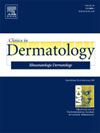Artificial intelligence for nonmelanoma skin cancer
IF 2.3
4区 医学
Q2 DERMATOLOGY
引用次数: 0
Abstract
Nonmelanoma skin cancers (NMSCs) are among the top five most common cancers globally. NMSC is an area with great potential for novel application of diagnostic tools including artificial intelligence (AI). In this scoping review, we aimed to describe the applications of AI in the diagnosis and treatment of NMSC. Twenty-nine publications described AI applications to dermatopathology including lesion classification and margin assessment. Twenty-five publications discussed AI use in clinical image analysis, showing that algorithms are not superior to dermatologists and may rely on unbalanced, nonrepresentative, and nontransparent training data sets. Sixteen publications described the use of AI in cutaneous surgery for NMSC including use in margin assessment during excisions and Mohs surgery, as well as predicting procedural complexity. Eleven publications discussed spectroscopy, confocal microscopy, thermography, and the AI algorithms that analyze and interpret their data. Ten publications pertained to AI applications for the discovery and use of NMSC biomarkers. Eight publications discussed the use of smartphones and AI, specifically how they enable clinicians and patients to have increased access to instant dermatologic assessments but with varying accuracies. Five publications discussed large language models and NMSC, including how they may facilitate or hinder patient education and medical decision-making. Three publications pertaining to the skin of color and AI for NMSC discussed concerns regarding limited diverse data sets for the training of convolutional neural networks. AI demonstrates tremendous potential to improve diagnosis, patient and clinician education, and management of NMSC. Despite excitement regarding AI, data sets are often not transparently reported, may include low-quality images, and may not include diverse skin types, limiting generalizability. AI may serve as a tool to increase access to dermatology services for patients in rural areas and save health care dollars. These benefits can only be achieved, however, with consideration of potential ethical costs.
人工智能治疗非黑色素瘤皮肤癌。
非黑色素瘤皮肤癌(NMSC)是全球最常见的五大癌症之一。非黑色素瘤皮肤癌是一个极有潜力应用包括人工智能(AI)在内的新型诊断工具的领域。在这篇范围综述中,我们旨在描述人工智能在NMSC诊断和治疗中的应用。29 篇文献介绍了人工智能在皮肤病理学中的应用,包括病变分类和边缘评估。25篇论文讨论了人工智能在临床图像分析中的应用,表明算法并不优于皮肤科医生,而且可能依赖于不平衡、无代表性和不透明的训练数据集。有 16 篇论文介绍了人工智能在 NMSC 皮肤手术中的应用,包括在切除术和莫氏手术中的边缘评估以及手术复杂性预测中的应用。11 篇出版物讨论了光谱学、共聚焦显微镜和热成像技术以及分析和解释其数据的人工智能算法。十篇出版物涉及人工智能在发现和利用非多发性硬化细胞生物标记物方面的应用。八篇论文讨论了智能手机和人工智能的使用,特别是它们如何使临床医生和患者有更多机会获得即时皮肤病评估,但准确性各不相同。五篇论文讨论了大型语言模型和 NMSC,包括它们如何促进或阻碍患者教育和医疗决策。三篇关于有色人种皮肤和 NMSC 人工智能的文章讨论了用于训练 CNN 的有限多样化数据集的问题。人工智能在改善 NMSC 的诊断、患者和临床医生教育及管理方面具有巨大潜力。尽管人工智能令人兴奋,但数据集往往没有透明的报告,可能包括低质量的图像,也可能不包括不同的皮肤类型,从而限制了普适性。人工智能可以作为一种工具,增加农村地区患者获得皮肤科服务的机会,并节省医疗费用。然而,只有考虑到潜在的道德成本,才能实现这些益处。
本文章由计算机程序翻译,如有差异,请以英文原文为准。
求助全文
约1分钟内获得全文
求助全文
来源期刊

Clinics in dermatology
医学-皮肤病学
CiteScore
4.60
自引率
7.40%
发文量
106
审稿时长
3 days
期刊介绍:
Clinics in Dermatology brings you the most practical and comprehensive information on the treatment and care of skin disorders. Each issue features a Guest Editor and is devoted to a single timely topic relating to clinical dermatology.
Clinics in Dermatology provides information that is...
• Clinically oriented -- from evaluation to treatment, Clinics in Dermatology covers what is most relevant to you in your practice.
• Authoritative -- world-renowned experts in the field assure the high-quality and currency of each issue by reporting on their areas of expertise.
• Well-illustrated -- each issue is complete with photos, drawings and diagrams to illustrate points and demonstrate techniques.
 求助内容:
求助内容: 应助结果提醒方式:
应助结果提醒方式:


